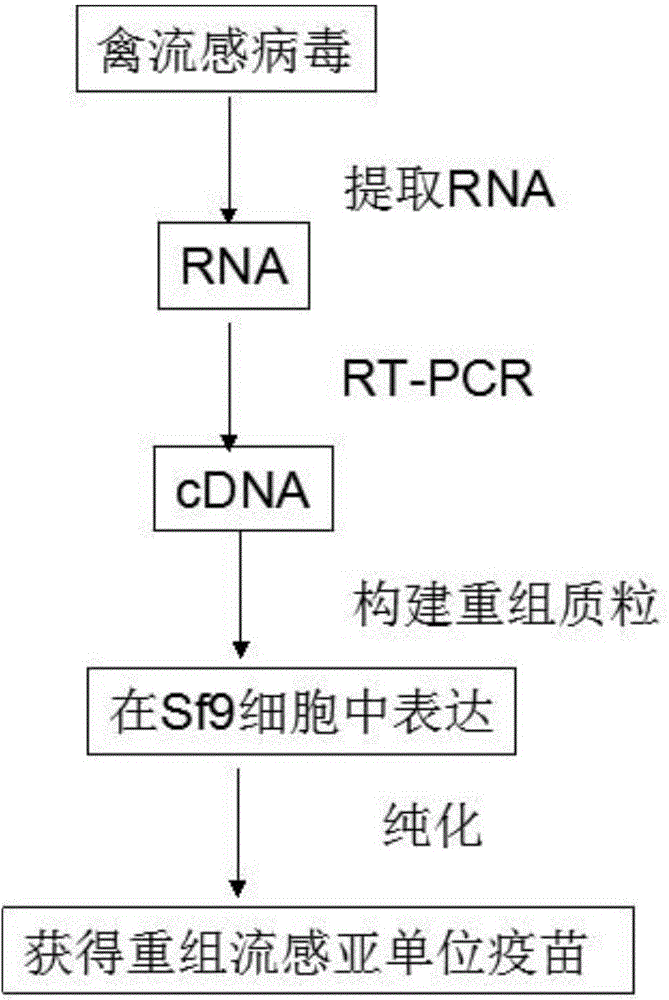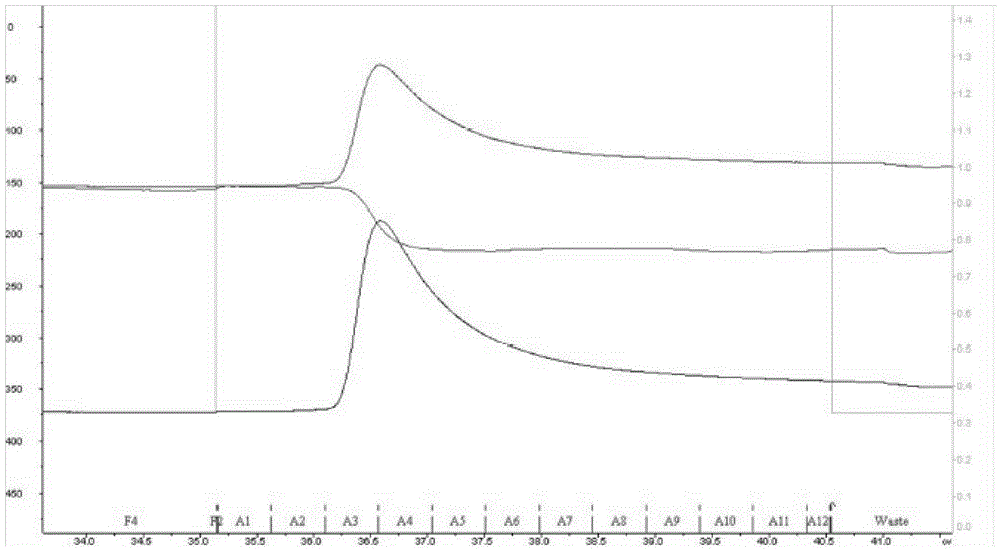Preparation method of recombinant avian influenza subunit vaccine
An avian influenza subunit and avian influenza technology, applied in the field of preparation of avian influenza subunit vaccine, can solve problems such as difficult to achieve effective prevention, poor vaccine immunization effect, long vaccine production cycle, etc., and achieve low production cost and high immune effect Good, easy-to-operate effect
- Summary
- Abstract
- Description
- Claims
- Application Information
AI Technical Summary
Problems solved by technology
Method used
Image
Examples
Embodiment 1
[0021] Example 1 Cultivate the virus strain A / Anhui / 1 / 2013 (H7N9), and extract the RNA in the virus strain
[0022] The A / Anhui / 1 / 2013 (H7N9) was obtained from the Chinese Center for Disease Control and Prevention (CDC).
[0023] Inoculate 0.2 mL of avian influenza virus strain A / Anhui / 1 / 2013 (H7N9) into 15-day-old chicken embryos, culture at 37°C for 40 hours, place in a refrigerator at 4°C overnight, and collect allantoic fluid aseptically. Take 500mL of viral allantoic fluid and centrifuge at 6000rpm for 20min at 4°C to collect the supernatant, centrifuge at 25000rpm for 2h and ultracentrifuge, resuspend the pellet in 5mL TEN, centrifuge with a sucrose gradient with a mass fraction of 10%-40%, centrifuge at 35000rpm for 2h, and collect a mass fraction of 30% -35% viral bands, dialyzed to remove sugar, suspended in RNase-free TE buffer, aliquoted, and frozen.
[0024] Use the QIANGEN RNeasy Mini Kit kit to extract RNA. For specific steps, please refer to the instruction man...
Embodiment 2
[0025] Embodiment 2 utilizes reverse transcription PCR to obtain cDNA
[0026] Take 10 microliters of the RNA bacterial suspension, add 20 pmol of primer 1 (the nucleic acid sequence shown in SEQ ID NO: 3) and mix well, then place it in a water bath at 70 degrees Celsius for 10 minutes, then add 5* reverse transcriptase buffer, 0.1 mol / LDTT 2 microliters, 2.5mmol / LdNTP 4 microliters, RNase inhibitor 1 microliter, M-MLV reverse transcriptase 10U, 37 degrees Celsius water bath for 1 hour, 97 degrees Celsius for 10 minutes. Obtain cDNA.
Embodiment 3
[0027] The cDNA obtained in Example 3 is used as a template to amplify the HA gene
[0028] Configure the reaction solution according to the following reaction system:
[0029] cDNA (50ng / μL)
1μL
Primer 1 (10 μmol / L)
1μL
Primer 1 (10 μmol / L)
1μL
1μL
10*Taq DNA polymerase buffer
5μL
dNTP (2.5mmol / L)
4μL
ddH2O
Make up 50μL
[0030] Amplify the HA gene according to the following reaction conditions:
[0031]
[0032] Primer 1 has a nucleic acid sequence as shown in SEQ ID NO: 3, that is, CCG GGTACC ATGAACACTCAAATCCTCGT, and has a KpnI restriction site.
[0033] Primer 2 has a nucleic acid sequence as shown in SEQ ID NO: 4, that is, AAT AAGCTTTTAGATACAGATTGTGCAGC, and has a HindIII restriction site.
[0034] The expanded HA gene has a nucleic acid sequence as shown in SEQ ID NO: 1, namely:
[0035] ATGAACACTCAAATCCTCGTTTTCGCCCTCATCGCCATCATCCCCACTAACGCTGATAAGATCTGCCTCGGTCA...
PUM
 Login to View More
Login to View More Abstract
Description
Claims
Application Information
 Login to View More
Login to View More - R&D
- Intellectual Property
- Life Sciences
- Materials
- Tech Scout
- Unparalleled Data Quality
- Higher Quality Content
- 60% Fewer Hallucinations
Browse by: Latest US Patents, China's latest patents, Technical Efficacy Thesaurus, Application Domain, Technology Topic, Popular Technical Reports.
© 2025 PatSnap. All rights reserved.Legal|Privacy policy|Modern Slavery Act Transparency Statement|Sitemap|About US| Contact US: help@patsnap.com



